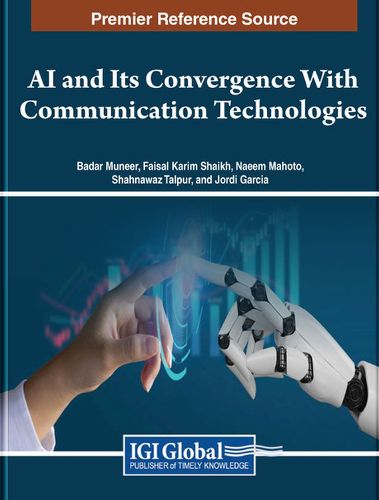Readings Newsletter
Become a Readings Member to make your shopping experience even easier.
Sign in or sign up for free!
You’re not far away from qualifying for FREE standard shipping within Australia
You’ve qualified for FREE standard shipping within Australia
The cart is loading…






This title is printed to order. This book may have been self-published. If so, we cannot guarantee the quality of the content. In the main most books will have gone through the editing process however some may not. We therefore suggest that you be aware of this before ordering this book. If in doubt check either the author or publisher’s details as we are unable to accept any returns unless they are faulty. Please contact us if you have any questions.
In today's world, the integration of Artificial Intelligence (AI) with Communication Technologies (ICT) has become an essential aspect of research and development. However, this convergence poses numerous challenges and bottlenecks that need to be addressed. Introducing AI and Its Convergence with Communication Technologies, a research book edited by a team of expert scholars, including Badar Muneer, Faisal Shaikh, Naeem Mahoto, Shahnawaz Talpur, and Jordi Garcia. This book offers an interdisciplinary platform that provides a comprehensive overview of the state-of-the-art research and practical challenges related to the AI convergence with ICT. It is designed for engineers, professionals, scientists, and academicians, providing them with insights into the ICT industry and research from an AI expert perspective. Readers associated with the field of computer science, information technology, software engineering, telecommunication, and electronics engineering will find this book to be beneficial. AI and Its Convergence with Communication Technologies covers a wide range of topics, including recent advancements and applications in AI; its uses in signal processing, mobile and modern wireless networks, decision-making and policy-making; and AI towards automation. It also addresses the potential applications of AI in the domains of national defense, military technology, hybrid warfare, medical & health sciences, and energy-efficient systems. Furthermore, the book highlights the strengths and weaknesses of AI convergence with ICT, along with emerging frontiers and recommendations. The book offers a brief history of AI in ICT and a comprehensive introduction to ICT-related methods and techniques in artificial intelligence and machine learning. It also covers data management with AI, data fusion, and knowledge discovery, as well as the use of AI in digital image processing. The book also emphasizes the role of AI in extracting knowledge and making predictions in decision-making strategies for businesses, management, and governance. Overall, this book provides a significant contribution to the understanding of AI and its convergence with communication technologies. While presenting a general trend and emergence of AI in ICT and related areas, it also highlights the challenges, limitations, and emerging frontiers. This book is a must-read for scholars and researchers who seek to understand the growing intersection of these two technologies and how it impacts modern industries and research.
$9.00 standard shipping within Australia
FREE standard shipping within Australia for orders over $100.00
Express & International shipping calculated at checkout
This title is printed to order. This book may have been self-published. If so, we cannot guarantee the quality of the content. In the main most books will have gone through the editing process however some may not. We therefore suggest that you be aware of this before ordering this book. If in doubt check either the author or publisher’s details as we are unable to accept any returns unless they are faulty. Please contact us if you have any questions.
In today's world, the integration of Artificial Intelligence (AI) with Communication Technologies (ICT) has become an essential aspect of research and development. However, this convergence poses numerous challenges and bottlenecks that need to be addressed. Introducing AI and Its Convergence with Communication Technologies, a research book edited by a team of expert scholars, including Badar Muneer, Faisal Shaikh, Naeem Mahoto, Shahnawaz Talpur, and Jordi Garcia. This book offers an interdisciplinary platform that provides a comprehensive overview of the state-of-the-art research and practical challenges related to the AI convergence with ICT. It is designed for engineers, professionals, scientists, and academicians, providing them with insights into the ICT industry and research from an AI expert perspective. Readers associated with the field of computer science, information technology, software engineering, telecommunication, and electronics engineering will find this book to be beneficial. AI and Its Convergence with Communication Technologies covers a wide range of topics, including recent advancements and applications in AI; its uses in signal processing, mobile and modern wireless networks, decision-making and policy-making; and AI towards automation. It also addresses the potential applications of AI in the domains of national defense, military technology, hybrid warfare, medical & health sciences, and energy-efficient systems. Furthermore, the book highlights the strengths and weaknesses of AI convergence with ICT, along with emerging frontiers and recommendations. The book offers a brief history of AI in ICT and a comprehensive introduction to ICT-related methods and techniques in artificial intelligence and machine learning. It also covers data management with AI, data fusion, and knowledge discovery, as well as the use of AI in digital image processing. The book also emphasizes the role of AI in extracting knowledge and making predictions in decision-making strategies for businesses, management, and governance. Overall, this book provides a significant contribution to the understanding of AI and its convergence with communication technologies. While presenting a general trend and emergence of AI in ICT and related areas, it also highlights the challenges, limitations, and emerging frontiers. This book is a must-read for scholars and researchers who seek to understand the growing intersection of these two technologies and how it impacts modern industries and research.